
Andy's Wonderful White
In another thread a few days ago, Andy (ananda) was discussing what a true artisan bread looked like and clipped a photo of this white bread in with a beautiful crumb structure. I asked him if he would share the details, which he was kind enough to oblige me.
The more proper name for this would be a Pain au Levain with mixed formula starters. It is made entirely with bread flour in my case and is truly a wonderful bread, even though I had a little trouble at the end. Here is the post with the formula I used.
This mix makes 3760+ grams of dough which I divided equally into 4-940g loaves. You could make half the batch easily enough but I needed some bread for friends I hadn't gifted in a while so I made the 8 Lbs.
The first build of a starter is done using a 100% feeding which gets it going on a fast pace. The second elaboration is done at 50% with the over all hydration thus far at 60%. The final dough mix is a 65% hydration mix so it is much easier to handle than the 80% Rubaud dough I have been playing with recently.
Another interesting aspect of this formula is that it calls for an overnight retarding of the starter after the second build. This is unusual for me as a step in the process but the flavor development is certainly noticeable.
I had a little trouble getting the levain incorporated evenly and eventually ended up using my DLX with the hook installed to mix the dis-similar masses. I also mis read the proofing and after 45 minutes baked the first pair of loaves while the remaining pair waited in the cool garage.
As you see, I proofed the first two using a couche and the second pair were proofed in a plastic banetton. And one of the loaves in a banetton was sprayed with water to see if I could encourage cracks. It's hard to see in these images but the crumb is translucent and very nice mouth feel.
I highly recommend that you try this bread. The flavor is outstanding, nutty, great after taste. My neighbor just called to tell me it was their favorite so far and they get a loaf of many many different breads.
Thank you Andy, this is truly a Wonderful White bread. Next time I'll let it proof longer, and there will be a next time.
Eric

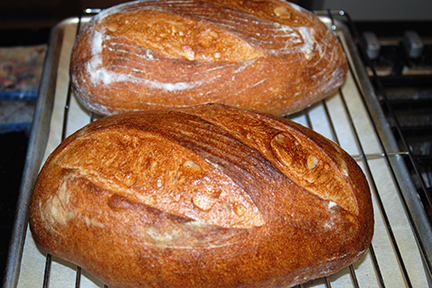

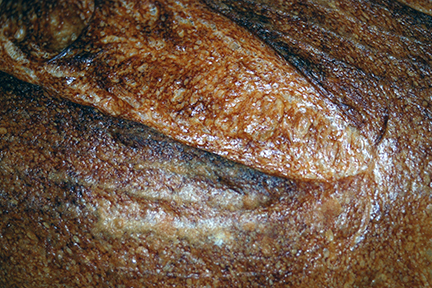
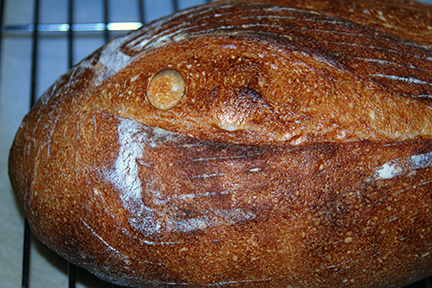
Is that a Fish?
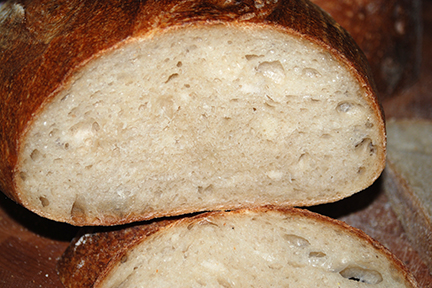
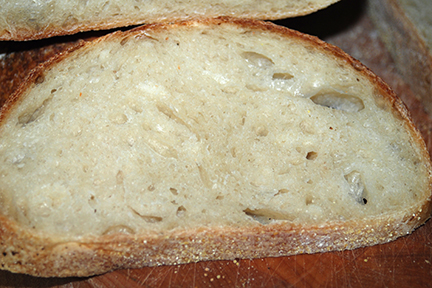


Comments
Hey Eric,
These look mighty fine specimens. Lovely looking crust to complement that translucent and open crumb you mentioned. Thanks for providing a link to my blog for those who haven't come across it yet, too.
Thank you for all your kind words and for joining the dialogue on pH. I am definitely getting the hang of that, but would like to catch up with a Chemistry teacher to see if I can further clarify. Remember, always that Acetic acid is a stronger acid than lactic. Concentration must be to do with how much acid. So for a given concentration, a combination of greater parts acetic must give lower pH than one with greater parts Lactic. That must be the case, yes?
I was wondering about posting on laminated yeasted dough for croissant manufacture as my next blog. Do you think that would be of interest to the good folks of FreshLoaf?
Best wishes, and thanks again
Andy
I appreciate your kind words on your bread. It is one of the best tasting breads I have eaten, I must say. Really great after taste.
Most if not all of the bakers here are home bakers but I know there has been interest in Croissants in the past. I'd like to see it I'm sure.
Eric
I love white breads this looks wonderfull.
Nice looking bread, Eric :-)
This is a beautiful bread. I love how the crumb turns out.
Thank you for posting the result of this very interesting formula.
Shiao-Ping
Your camera ability is right up there with your baking ! I will have to read the whole thread to see what you made but I sure do like the looks of it. c
Looks great. Nice work, Eric.
Thanks korish! I'm pretty happy with it for a first try.
Debra: I'm glad I'm not the only one who sees that. Thanks
Shiao-Ping: Thank you. It is interesting. Now that I think about it, it's a little like a poolish feeding a firm starter. I plan on making this again with a little white rye.
Trailrunner: Thanks, I appreciate your words.
Thanks Floyd. It feels like back to basics to learn the secret of flavor.
Eric
My starter has been in the fridge and neglected for 2 weeks now. Looks like it will be liberated tomorrow. I'm wondering, Eric (or Andy), what flour to use. I have some Harvest King (Gold Medal) bread flour, but I've read that it's lower in protein content than KAF AP, which is what I normally use for my sourdough bread (which I've been happy with, but it's certainly nothing to blog about). I love the creamy look of the crumb in your Pain au Levain.
Thanks for you comments Edith.
I generally use GM Better for Bread also and find it works as well as KA AP. I used Dakota Maid Bread Flour for this but I'm sure the GM would be fine. That's my normal higher gluten flour.
Just make sure your starter is at peak performance when you start the first build.
Hi Edith,
As I live in the UK I'm probably not best qualified to comment on flour in the US.
I think Dan Leader makes reference to Giusto's, as do Wing and Scott. I would imagine Hamelman uses King Arthur!
We don't have an "All-Purpose" grade over here. The standard roller-milled branded flours sold in 1.5kg bags are labelled as "Strong" for bread, "Plain" for cakes, biscuits, sponges and pastry [short], and "Self-Raising" where a raising agent has been added. Our Plain Flour does not make good bread; that is because of our climate and intensive grain growing systems not lending themselves to bread wheat.
I'm sure Eric's advice is sound enough on flour.
The idea of the first build is to bring the levain back into condition. The second build should then fully invigorate your cultures of yeasts and bacteria ready to make the final dough.
Best wishes
Andy
Am I reading the formula correctly, that the formed loaves are proofed for about 5 hours? Mine will probably take that long. First build bubbled away all day yesterday, even though I did not refresh it before starting this. The second build did not show much activity in the 3 hours before refrigerating. Just took it out of the fridge this morning and it looks kinda quiet. I am still hopeful.
Edith
This would be about right Edith.
However this is entirely down to making the dough cold, quite deliberately.
I did not record any probe readings, sorry. As I explained in my post, which Eric has directed you to above, I wrote the formula up on the back of an envelope, and didn't write anything down subsequent to that. So to some extent, everything I've detailed is a best guess, from memory only.
I know that my leaven was spot on; but again cold.
If leaven and final dough had been worked up at say 28*C, I reckon these loaves would have proved say 1-2 hours bulk, and just over 2 hours final proof. Again, my best guess.
Hope that helps
Andy